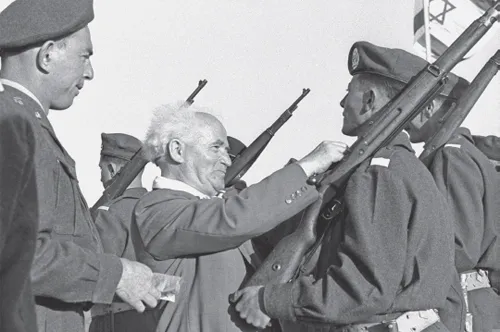![]()
1. THE SUEZ CANAL CRISIS
One of the unusual ironies of recent Middle East history centres on a succession of events in Egypt in 1956 that resulted in a civil war in Lebanon, which lasted almost forty years.
The initial focus of attention was the Suez Canal and an invasion of Egyptian territory by a combined British, French and Israeli strike force that included jet fighter-bombers, aircraft carriers, and an attack force led by squads of paratroopers from all three nations.
Referred to at the time as the Tripartite Aggression (and in Arab circles as the Kadesh Operation), Cairo retaliated by exercising the only option it had left: it blocked the canal by sinking ships in the navigating channel, thus plugging what was then the world’s most important maritime trade route between Europe, the Persian Gulf Asia and Australasia.
When Lebanese President Camille Chamoun, a pro-Western Christian, who enjoyed the support of the Americans, refused to condemn the invasion, Egypt and Syria – again at the behest of the Soviets – joined forces in a bid to overthrow his government in Beirut. It was the first real test of strength for both superpowers in the eastern Mediterranean, a situation that was both fluid and volatile, and one that persists to this day.
Though the actual invasion was relatively brief – British and French forces were on Egyptian soil for less than two months and the Israelis withdrew three months later – the catalyst for the initial attack was unquestionably the nationalization of the Suez Canal by Egyptian leader Gamal Abdel Nasser in July 1956.
The situation had been brewing a while. Two years before, in 1954, Cairo had begun pressuring London to terminate its military presence in the Canal Zone, which had been granted in the 1936 Anglo-Egyptian Treaty.
In the interim, Egyptian and Israeli armed forces faced off several times along their common border. By the time fighting had ended, all three allies had attained a number of military objectives, but the canal was now useless and heavy pressure from both Washington and Moscow forced them to withdraw.
Port Said at the Mediterranean end of the Suez Canal, 1930s. (Image Marc Ryckaert)
The London Evening Standard of 9 November 1956.
US President Dwight D. Eisenhower meeting with Egyptian President Gamal Abdel Nasser, United Nations, New York, September 1960. (Bibliotheca Alexandrina)
What certainly complicated matters was the fact that American President Dwight Eisenhower had initially been kept in the dark about the intentions of the attackers: he was furious that they went ahead after he had strongly warned Britain and France not to invade. Threatening serious damage to both the British and French financial systems, the two nations held out only briefly before pulling out.
The Suez Canal was closed from October 1956 until March 1957, with the Jewish state fulfilling some of its objectives, such as attaining freedom of navigation through the strategic Straits of Tiran.
As a result of the conflict, the United Nations created a peacekeeping force to police the Egyptian–Israeli border, which operates in the Sinai Peninsula to this day. British Prime Minister Anthony Eden was obliged to resign and, more ominously, the Soviet Union may have been emboldened by the joint pull-back to invade Hungary.
It is worth mentioning that the author at the time was serving in the South African Navy in Simon’s Town. At first hand he was able to observe one of the immediate side effects the canal closure had on South Africa, which had recently created several controversial laws that affected ‘people of colour’. Obviously, the Apartheid system of race classification should have affected most Third World nations and their so-called ‘Non-White’ crews. This included warships from Pakistan, India and Iran, as well as one of two other countries when their ships, of necessity, stopped at South African ports if they were travelling to or from Europe. But it did not. Simon’s Town was visited by several Pakistani and Iranian naval craft, and other South African harbours, a lot more discreetly, by the Indian Navy.
The fact that Egypt had negotiated a series of arms deals with communist Czechoslovakia in September 1955 – and thereby ending Egypt’s reliance on Western military supplies – was to become a significant factor in the debacle that followed. It was also to influence subsequent events because later, at the behest of the Kremlin, other members of the Warsaw Pact sold arms to Egypt and Syria.
A British-manufactured Archer tank destroyer captured by Israelis from the Egyptian army in the Sinai, November 1956. (Courtesy of GPO, Israel)
In practice, all sales from the Eastern Bloc were authorized by the Soviet Union, in an attempt to increase Moscow’s influence over the Middle East, thereby creating a situation where war – in fact several conflicts – eventually became inevitable.
Political relations between Israel and the Soviet Union remained poor throughout the Cold War, with the Soviets helping Arab states such as Syria, Egypt, Libya, Yemen, Algeria and Iraq improve their military capabilities by providing state-of-the-art weaponry and training.
British historian Paul Johnson and other notable figures who were vocal about Middle East developments argued that the 10 November 1975 United Nations General Assembly Resolution 3379, which labelled Zionism as racism, was orchestrated by the USSR.
It was rescinded by Resolution 4686 in December 1991, which coincided with the dissolution of the Soviet Union.
Notable about the events that preceded the Suez invasion is the fact that nine members of United Nations Security Council signified support of the resolution that endorsed the ongoing operation of the Suez Canal. That took place only a month before the actual invasion, on 14 October 1956.
The Eisenhower administration, meanwhile, worried by the prospect of the outbreak of hostilities between its NATO allies and an emergent, influential Middle Eastern power (and the possible intervention of the Soviet Union in such a conflict), attempted to broker a diplomatic settlement of the British-French-Egyptian dispute.
On 9 September, American Secretary of State John Foster Dulles proposed the creation of a Suez Canal Users’ Association (SCUA), an international consortium of eighteen of the world’s leading maritime nations, the idea being to create a substantive body that would link up with Egypt to operate the canal. Although SCUA would have given Britain, France, and Egypt an equal stake in the canal, this, and various other United States and international mediation efforts failed to win the full support of any of the contending powers, in large part because the Soviets were opposed to the plan.
Sinai Campaign. Israeli troops marking the demarcation lines between the Yugoslav UNEF troops, 25km from El Arish, 1957. (Courtesy of GPO, Israel)
In discussions with the United States between August and October that year, the British government repeatedly hinted that it might resort to force in dealing with Nasser. At the same time, the British and French held secret military consultations with Israel, who regarded Nasser as a threat to its security, resulting in the creation of a joint plan to invade Egypt and overthrow its president.
As we now know, in keeping with these plans, Israeli forces attacked across Egypt’s Sinai Peninsula, advancing to within 10 miles of the Suez Canal, followed by the French and British onslaught.
Sinai Campaign. UNEF Yugoslav soldiers between El Arish and Rafa, 1957. (Courtesy of GPO, Israel)
In is interesting that the Israelis struck the first blow, which took place on 26 October 1956. Two days later, they were joined by British and French military forces, though the original plan was for all three to launch their strikes simultaneously.
Behind schedule, but ultimately successful, British and French troops took control of the area around the Suez Canal. However, their hesitation gave the Soviet Union – confronted with a growing crisis in Hungary – time to respond.
Eager to exploit Arab nationalism and gain a foothold in the Middle East, Moscow arranged for the supply of weapons, and eventually helped Egypt construct the Aswan Dam on the Nile River after the United States had refused to support the project.
More salient, Soviet leader Nikita Khrushchev, for the first time since the end of World War Two threatened to attack Western Europe with nuclear weapons if Britain and France did not desist.
President Eisenhower’s approach was more balanced, though he did threaten all three tripartite nations with economic sanctions if they persisted in their attacks.
In Lebanon meanwhile, as a consequence of President’s Chamoun’s actions by not condemning the attack on Egypt, a threat of civil war emerged between Lebanon’s Christian Maronites and the country’s more populous Muslim residents, both Sunni and Shi’a.
Demands made by the Islamic communities were direct: break diplomatic relations with the Western powers that had attacked Egypt or face the consequences. Matters came to a head in July 1958, when tensions were further distorted by President Chamoun displaying an affinity to the pro-West Baghdad Pact.
Shortly afterwards, in July 1958, following the toppling of a pro-Western government in Iraq’s 14 July Revolution, along with the internal instability in his own country (the supply of Egyptian arms to Lebanese dissidents through Syria), President Camille Chamoun was forced to call for assistance from the United States.
The Danish cargo vessel, Inge Toft, arriving in Haifa following the Egyptian refusal to allow it passage through the Suez Canal with Israeli cargo, 1960. (Courtesy of GPO, Israel)
Israeli Prime Minister David Ben-Gurion at an officer’s badge passing-out parade, 1952. (Courtesy of GPO, Israel)
That aid, almost all of it military, and in the face of a possible Soviet reaction, was not long in coming.
![]()
2. THE 1958 AMERICAN INVASION
In July 1958, Lebanon was threatened by a civil war between Maronite Christian Arabs and and their Islamic counterparts.
As we have seen, tensions with Egypt had escalated two years earlier when Lebanon’s pro-Western President Camille Chamoun, a Christian, refused to break diplomatic relations with the Western powers that attacked Egypt during the Suez Canal crisis. That angered the Egyptian President Gamal Abdel Nasser who, we now know – at the behest of the Kremlin – decided to act in a bid to destabilize the Levant.
Tensions were further compounded when President Chamoun demonstrated an affinity to the Western-orientated Baghdad Pact, which, Nasser believed, posed a threat to Arab nationalism. As a response, Egypt and Syria united to create the short-lived but extremely hostile United Arab Republic (UAR).
The Lebanese Sunni prime minister, Rashid Karami – Chamoun’s opposite number in government – supported Nass...








